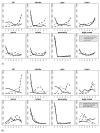Assessing agreement of self-reported and observed physical exposures of the upper extremity
- PMID: 20166314
- PMCID: PMC3579613
- DOI: 10.1179/107735210800546227
Assessing agreement of self-reported and observed physical exposures of the upper extremity
Abstract
Assessment of workplace physical exposures by self-reported questionnaires has logistical advantages in population studies, but is subject to exposure misclassification. This study measured agreement between eight self-reported and observer-rated physical exposures to the hands and wrists, and evaluated predictors of intermethod agreement. Workers (n = 341) from three occupational categories (clerical/technical, construction, and service) completed self-administered questionnaires and worksite assessments. Analyses compared self-reported and observed ratings using a weighted kappa coefficient. Personal and psychosocial factors, presence of upper extremity symptoms, andjob type were evaluated as predictors of agreement. Weighted kappa values were substantial for lifting (0.67) and holding vibrating tools (0.61), moderate for forceful grip (0.58), and fair to poor for all other exposures. Upper extremity symptoms did not predict greater disagreement between self-reported and observed exposures. Occupational category was the only significant predictor of inter-method agreement. Self-reported exposures may provide a useful estimate of some work exposures for population studies.
Figures



Similar articles
-
Reliability of job-title based physical work exposures for the upper extremity: comparison to self-reported and observed exposure estimates.Occup Environ Med. 2010 Aug;67(8):538-47. doi: 10.1136/oem.2008.044339. Epub 2010 Apr 21. Occup Environ Med. 2010. PMID: 20410076 Free PMC article.
-
Self-reported physical work exposures and incident carpal tunnel syndrome.Am J Ind Med. 2014 Nov;57(11):1246-54. doi: 10.1002/ajim.22359. Epub 2014 Sep 15. Am J Ind Med. 2014. PMID: 25223617 Free PMC article.
-
A prospective study of musculoskeletal outcomes among manufacturing workers: I. Effects of physical risk factors.Hum Factors. 2014 Feb;56(1):112-30. doi: 10.1177/0018720813491114. Hum Factors. 2014. PMID: 24669547
-
Dupuytren's disease and occupational mechanical exposures: a systematic review and meta-analysis.Occup Environ Med. 2024 Oct 23;81(10):535-542. doi: 10.1136/oemed-2024-109649. Occup Environ Med. 2024. PMID: 39317441
-
Studies of upper limb pain in occupational medicine, in general practice, and among computer operators .Dan Med J. 2018 Apr;65(4):B5466. Dan Med J. 2018. PMID: 29619928 Review.
Cited by
-
Occupational demands associated with rotator cuff disease surgery in the UK Biobank.Scand J Work Environ Health. 2023 Jan 1;49(1):53-63. doi: 10.5271/sjweh.4062. Epub 2022 Oct 13. Scand J Work Environ Health. 2023. PMID: 36228192 Free PMC article.
-
Occupational tasks associated with shoulder pain and upper extremity disability: a cross-sectional study in the Johnston County Osteoarthritis Project.BMC Musculoskelet Disord. 2024 May 11;25(1):374. doi: 10.1186/s12891-024-07487-x. BMC Musculoskelet Disord. 2024. PMID: 38730454 Free PMC article.
-
Physical Exposures, Work Tasks, and OSHA-10 Training Among Temporary and Payroll Construction Workers.J Occup Environ Med. 2018 Apr;60(4):e159-e165. doi: 10.1097/JOM.0000000000001267. J Occup Environ Med. 2018. PMID: 29280774 Free PMC article.
-
Long COVID and its association with neurodegenerative diseases: pathogenesis, neuroimaging, and treatment.Front Neurol. 2024 Apr 4;15:1367974. doi: 10.3389/fneur.2024.1367974. eCollection 2024. Front Neurol. 2024. PMID: 38638307 Free PMC article. Review.
-
Validity and Reliability of the Upper Extremity Work Demands Scale.J Occup Rehabil. 2017 Dec;27(4):520-529. doi: 10.1007/s10926-016-9683-9. J Occup Rehabil. 2017. PMID: 27848067 Free PMC article.
References
-
- US Department of Labor. US Bureau of Labor statistics Occupational Injuries and Illnesses: Counts, Rates and Characteristics. Number and incidence rates of injuries and illnesses due to musculoskeletal disorders, by selected occupations, private industry. 2006. Report 1014.
-
- Winkel J, Mathiassen S. Assessment of physical work in epidemiology studies: concepts, issues and operational considerations. Ergonomics. 1994 Jun;37(6):979–88. - PubMed
-
- Spielholz P, Silverstein B, Morgan M, Checkoway H, Kaufman J. Comparison of self-report, video observation and direct measurement methods for upper extremity musculoskeletal disorder physical risk factors. Ergonomics. 2001 May 15;44(6):588–613. - PubMed
-
- Punnett L, Wegman DH. Work-related musculoskeletal disorders: the epidemiologic evidence and the debate. J Electromyogr Kinesiol. 2004 Feb;14(1):13–23. - PubMed
Publication types
MeSH terms
Grants and funding
LinkOut - more resources
Full Text Sources
Medical
